Abstract
In this study, a combination of geopolymers including Rafsanjan Natural Pozzolan (RNP), Cement Kiln Dust (CKD), and an activator such as Calcium Carbide Residue (CCR) or NaOH was used to stabilize and improve the poorly graded sandy soil. Factors such as the activator type, activator concentration, CKD and RNP content were studied. Chemical compounds of the soil and abovementioned materials were investigated using X-ray Diffraction (XRD) and X-ray Fluorescence (XRF) detection tests. Unconfined Compressive Strength (UCS) tests were carried out to evaluate the mechanical behavior of the specimens. The findings revealed that CKD, which is a hazardous byproduct, could be turned into an eco-friendly construction material through geopolymerization. The presence of CKD along with NaOH significantly increased the UCS of the samples compared to unstabilized specimens (control 1). Microstructural analyses using Scanning Electron Microscopy (SEM) confirmed the desirable distribution of the geopolymer gel in the stabilized soil. According to the SEM images, it was observed that the samples stabilized with CKD had a higher strength than those stabilized with CKD combined with RNP due to the formation of a greater amount of gel and a stable microstructure. The findings of this research promote sustainable ground improvement techniques using waste by-products.
1. Introduction
The stabilization and strength enhancement techniques are known as practical and economical approaches that resolve the issues with problematic soils [1] to turn them into useful georesources. Traditionally, the use of Portland cement or lime has been a common method for soil stabilization which is known to be a non-environmentally friendly approach [2,3]. Annually, up to 8% of manmade CO2 emissions are known to be due to cement production in the world [4]. Another problem with cement production is the creation of millions of tons of waste in the form of cement kiln dust (CKD). About 14.2 million tons of CKD are produced in the United States each year [5]. The replacement of cement with geopolymer made of CKD would hence be a sustainable approach contributing to less depletion of natural resources and less emission of CO2 into the atmosphere. Geopolymers have attracted the attention of many researchers due to their superior properties and positive environmental impact when compared to cement [6,7]. In the last decades, extensive works by various researchers have shown that geopolymers can not only be used as an appropriate cement replacement, but also result in up to 80% reduction in the emission of greenhouse gases in their production, compared with cement. Geopolymers have also shown high durability, heat resistance and chemical attack resistance, and low consumption of natural resources in their production [8].
Natural pozzolans are rich sources of alumina and silica and are considered as valuable georesources. Bondar studied different kinds of natural pozzolans aiming to identify activators and related methods for the production of a geopolymer concrete as a new construction material. The results indicated that the concrete produced using alkali-activated natural pozzolans (AANP) exhibited moderate to high mechanical strength [9]. Several researchers have investigated different wastes such as CKD and calcium carbide residue (CCR) to investigate their applicability in geopolymerization. CCR is a by-product of the acetylene gas production process [10], which can potentially be utilized as an alkaline activator with a high pH due to being rich in Ca(OH)2 [11]. Phetchuay et al. used a geopolymer based on Fly Ash (FA) and CCR for the improvement of the stability and strength of clay [12]. Their findings showed that in the active zone, adding CCR increased the strength of the geopolymer. Phummiphan et al. studied the marginal lateritic soil stabilized by CCR and Fly Ash (FA) geopolymers. Their experimental results showed that the unconfined compressive strength (UCS) of saturated soil-FA lateritic geopolymer samples met the 7-day strength requirements for light and heavy pavements. In addition, the 7-day UCS of the samples increased with the increasing CCR replacement ratio [13,14]. Pourabbas et al. investigated the use of CCR and recycled glass powder as the activator and the precursor, respectively, to stabilize clay soils. Their results showed that both CCR and recycled glass powder can effectively enhance the mechanical properties of clay [15].
The production of CKD, as well as unattended depot in the open environment, have many risks including scattering in the air and leaking into the underground water and having no economic justification. Therefore, any use of it, including soil stabilization, can lead to the formation of stable and innovative materials that are valuable in terms of engineering and would not lead to the aforementioned risks. Adianjo and Okeke, discussed the feasibility of using CKD in the stabilization of weak clay soils stating that: “The possibility of using CKD generated and dumped in open dump site with no economic or environmental benefit was investigated” [16]. Salih et al. pointed out, in their article, that huge deposits of industrial waste materials such as CKD were observed and available in many different parts of the world, which can be used in economic and cheap ways to stabilize the soil, in order to reduce their environmental effects [5]. Naseem et al. mentioned that CKD and other similar materials are industrial wastes, which can all pose risks to the sustainability of the environment [17].
Ahmari et al. investigated the addition of CKD to improve the compressive strength of the geopolymer [18]. The results of their study showed that adding up to 10% of CKD powder had little effect on increasing the strength while adding 15% CKD considerably increased the compressive strength. Khater et al. (2013, 2019) studied geopolymer materials based on metakaolin and CKD powder having 25 and 50% by weight of materials, respectively. Their study showed that increasing the CKD content volume increased the Unconfined Compressive Strength (UCS) of the samples [19,20].
The use of geopolymers in improving the properties of problematic soils has been studied by several researchers. Al-Rekaby and Odeh used a class C fly ash-based geopolymer to stabilize clay soils with different percentages of sand. They used sodium hydroxide and sodium silicate solution as the alkaline activator. Their results showed that the stabilized soil had a high compressive strength of about 1 to 8 MPa while the unstabilized soil had a strength of less than 0.3 MPa. They also reported that mixing sand with clay caused a reduction of the optimal ratio of alkaline activator from 0.8 for clay with 5% sand to 0.6 for clay with 10–30% sand [21]. Qaidi et al. carried out a comprehensive study on how mine tailings could be recycled for geopolymer production. They discussed recent advances in the production of geopolymer composites derived from mine tailings as sustainable and environmentally friendly materials [22]. Parthiban et al. investigated the role of industrial waste in stabilizing loose soils. In their review study, the effect of loose soil remediation using industrial precursors on soil engineering performance and its environmental impacts was investigated and discussed [23].
The Rafsanjan Natural Pozzolan (RNP) is a naturally available material with significant amounts of alumina and silica. However, to the best of the authors’ knowledge, no comprehensive studies have been carried out on the stabilization of sandy soils using geopolymers based on RNP and CKD. As a result, the current study was carried out to investigate: (a) the effectiveness of the stabilization of poorly graded sandy soil with geopolymer, based on CKD and RNP in the presence of an alkaline activator such as CCR or NaOH in ambient conditions; (b) choosing between NaOH and CCR through investigating their effects on increasing the compressive strength of the stabilized soil; and (c) the effect of presence or absence of CKD and RNP on the strength of stabilized soil. In objective (c), the aim was to determine whether CKD or RNP are more suitable as the geopolymer base material to stabilize the soil. The outcomes of this research are useful in promoting the reuse of waste and industrial byproducts for ground improvement and road construction projects and the development of more sustainable construction materials.
2. Materials
The materials used in the present study included RNP, CKD, NaOH, CCR and dune sand often classified as poorly graded sand (SP) according to the Unified Soil Classification System.
2.1. Natural Soil
The naturally occurring sand of this study was collected from Joupar Road, located in the Kerman province in Iran (30°11′23″ N 57°03′20″ E), at a depth of 200 mm from the surface (Figure 1, adopted from Google Maps and modified). Without stabilization, this type of sand is not suitable for construction due to its uniform particle size distribution, less cohesion, and its unsuitability for compaction.
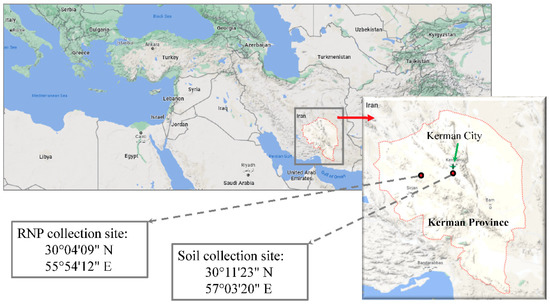
Figure 1.
The location of the sites where the soil and RNP were collected.
The particle size analysis was carried out on the soil following ASTM D422-63 [24] on RNP, CKD, NaOH, CCR using a laser analyzer, as shown in Figure 2, together with the images of these materials. The collected sand was passed through a No.4 sieve (4.75 mm) to remove the random gravel size particles (<1%) for the consistency of prepared specimens. The physical properties of the soil are summarized in Table 1, including the Maximum Dry Density (MDD) and the Optimum Moisture Content (OMC) using the standard Proctor method [25]. It is known that when using geopolymer-based additives for soil stabilization, the MDD and OMC do not change significantly [26]. Therefore, all stabilized and unstabilized samples of this research were compacted with the same OMC. The chemical composition of the sand used in this research is presented in Table 2.

Figure 2.
The particle size distribution and images of soil, RNP, CCR and CKD.

Table 1.
Physical and compaction properties of used soil.

Table 2.
Chemical Compositions of CCR, CKD, RNP and the sandy soil.
2.2. Rafsanjan Natural Pozzolan (RNP)
The RNP was taken from a local company in the south east of Iran (30°04′09″ N 55°54′12″ E) as shown in (Figure 1) to be used as the raw base geopolymer material. The RNP used in this study corresponds to ASTM C618-19 class N [29]. The collected RNP was ground into finer particles by an industrial mill and was next passed through the No. 200 sieve (<0.075 mm). The gradation of the ground RNP, as demonstrated in Figure 2, was determined using a laser particle size analysis device.
2.3. Cement Kiln Dust Powder (CKD)
The CKD powder was supplied by the Momtazan Cement Factory in Kerman, Iran. The CKD was passed through a No. 40 sieve (0.425 mm) to remove the CKD particles that had turned into agglomerated pellets due to ambient humidity. The particle size distribution curve for CKD, which was obtained using a laser particle size analyzer, is demonstrated in Figure 2.
2.4. Alkaline Activators
Alkaline activators used in this study included CCR and NaOH. CCR is a waste by-product of the acetylene (C2H2) production process. The chemical formula related to its production process is presented in Equation (1):
CaC2 + 2H2O → C2H2 + Ca(OH)2
CCR is mainly composed of Ca(OH)2 or CaO because of its high alkaline properties (pH > 12), and can provide suitable conditions for leaching alumina and silica particles [11]. The CCR used in this study was dried at a temperature of 60 °C for 3 days and passed through a No. 40 sieve. The particle size distribution of CCR (Figure 2) shows that more than 95% of the particles are smaller than 0.075 mm. The dry NaOH was collected from a commercial store and was mixed with tap water for the experimental work. The alkaline activators in CKD-RNP-CCR (CRC) and CKD-RNP-NaOH (CRN) geopolymers were composed of a combination of CCR with CKD and RNP, and NaOH with CKD and RNP, respectively.
3. Testing Program
A testing program was developed to investigate the effect of various parameters, listed below, on the compressive strength of stabilized soil samples:
- Variation in the content of materials,
- Presence or absence of RNP and CKD,
- The type of alkaline activator (NaOH or CCR), and
- The effect of curing time on the geopolymerization process and distribution of geopolymer gel on the stabilization of sandy soil.
First, a combined geopolymer based on the RNP and the CKD powder was made at the ambient condition in the presence of CCR as an alkaline solution. Next, in order to study and compare the effect of the alkaline solution type, the CCR was substituted with NaOH alkaline solution. To understand the effect of RNP and CKD powder in the geopolimerization process, these materials were removed one at a time from the geopolymer. The planned testing program is presented in the flowchart of Figure 3.
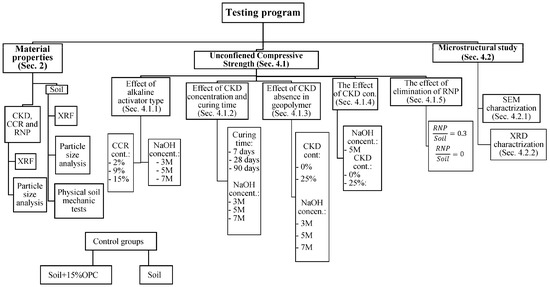
Figure 3.
The flowchart presenting the testing program.
3.1. X-ray Fluorescence (XRF) Analysis
The XRF analysis was performed to determine the amount of oxides in the soil, CCR, RNP and CKD. The XRF results are presented in Table 2. For RNP, the total value of Fe2O3 + SiO2 + Al2O3 is 82.4%. According to ASTM C618 [29], the amount of alumina silicate should be at least 70% of the total amount of the composition, and considering that the desired amount for pozzolan is above 70%, it is an acceptable amount for creating geopolymer gel [29].
3.2. Specimen Preparation and Unconfined Compressive Strength (UCS) Tests
The UCS test results were meant to be used as a criterion to compare the strength characteristics of various specimens made with different stabilizer material contents. The specimens were prepared using a solid steel cylindrical mold with an internal diameter of 50 mm and a height-to-diameter ratio of 2.0. The suitable amount of materials required for each group of samples was carefully prepared in a 10-min course of mixing process using an industrial mixer.
CCR does not dissolve completely in water. Therefore, to prepare samples with CCR as the activator, instead of mixing it with water, first, CCR was added to the soil (by 2%, 9% and 15% weight of dry soil) in the dry condition. Next, predetermined amounts of RNP and CKD were added to the mixture and finally, the required water according to the OMC was added.
To prepare samples with NaOH as the activator, sodium hydroxide solution was prepared based on its molar mass and the molar concentration of the desired solution. As an example, when the molar mass of NaOH was 40 gr/mol, a 5 M concentration of sodium hydroxide solution was achieved, if 5 × 40 = 200 g of NaOH was dissolved in one liter of aqua solution. Then the solution was mixed for 10 min to get completely homogeneous. The solvation is essentially highly exothermic. In the present study, for sample preparation, an alkaline activator solution was prepared at ambient temperature 24 h before use, and was allowed to reach thermal equilibrium with the environment to dissipate the excess heat. Therefore, the temperature of the environment and the prepared mixture were eventually equal to the temperature of the environment, which was 27 ± 1 °C.
Finally, to reach the OMC of the soil, additional water was added to the mixture. The prepared mixtures were poured into the mold in three successive thickness-controlled layers for compaction. Each layer was compacted to reach the corresponding MDD under the standard compaction energy. The samples were next extruded from the compaction mold, wrapped with a plastic film, and placed inside a zipped plastic bag to be cured in ambient conditions. All samples were tested according to the ASTM D2166-87 standard after 7, 28 and 90 days of curing. The cured specimens were placed in the loading equipment for UCS testing with a rate of axial deformation fixed at 1 mm/min [30] and the peak loads before failure of specimens were collected.
The specimens prepared with various compound characteristics in this research are summarized in Table 3. The unstabilized soil and stabilized soil samples with 15% ordinary portland cement (OPC) were prepared as control groups.

Table 3.
The ID and specifications of the specimens.
3.3. Microstructural Analysis
The SEM and XRD microstructural analyses were carried out on selected geopolymer treated specimens and control specimens after the UCS test. Small pieces of specimens for such analyses were taken from fractured parts of the specimens that failed the UCS tests. For taking the images, both the Back Scattered Electrons (BSE) and Secondary Electrons (SE) modes were used. The results of these tests are provided and discussed in Section 4.2.
The moisture condition, at the time of test, was air-dried and the initial synthesis temperatures (°C) was the ambient condition.
4. Results and Discussions
4.1. The UCS Test Results
4.1.1. The Effect of Alkaline Activator Type
The type of alkaline activator has a great impact on the formation and distribution of the geopolymer gel. The specimens developed in Groups 2 and 3 contained 25% CKD, the RNP/Soil ratio of 0.3, and various CKD contents and NaOH concentrations as presented in Table 3. As demonstrated in Figure 4, Group 3 specimens, exhibited higher UCS than those having various percentages of CCR in Group 2. Since the Sodium in NaOH is more reactive compared to the Calcium in CCR, the rate of strength development was more accelerated in Group 3, which led to an enhanced final compressive strength. Calcium (Ca2+) is known to have a larger valance than Sodium (Na+) and it has less tendency to be replaced by the attacking cation.
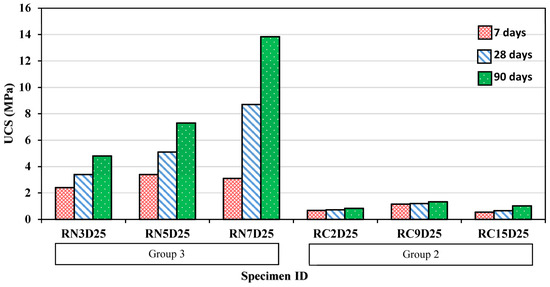
Figure 4.
The effect of alkaline activator type and concentration on UCS of stabilized specimens (CKD = 25%, RNP/Soil = 0.3) with 7, 28 and 90 days curing time.
The pure CCR has a relatively high pH, while a mixture of CCR, soil, and other additives has a relatively lower pH. Due to the low pH at low concentrations of CCR, a small amount of amorphous aluminosilicate dissolves. Greater dissolution of aluminosilicate sources increases with increasing CCR concentration [15]. The UCS results showed that the strength of samples containing up to 9% of CCR alkaline activator increased. However, beyond CCR content, a reverse trend in strength was observed. Such a phenomenon could be due to the increase in the concentration of the alkaline activator, which was due to the increase in the amount of calcium oxide (CaO) in the environment. This could decelerate the geopolymerization process or even prevent it. Decelerating geopolymerization could subsequently reduce water absorption, thereby significantly reducing UCS [15]. A similar trend was observed in the work by Kampala and Horpibulsuk (2013) [31], who stabilized the silty clay soil with CCR. Their results showed that the highest strength was obtained at 7% CCR content. In addition, according to Figure 4, in specimens containing CCR, increasing the curing time from 7 to 90 days did not have a significant effect on increasing the strength of the stabilized samples. This shows that the type of alkaline activator has a major effect on the geopolymerization reaction and hence, greatly affects the strength development of specimens. As the UCS results of specimens containing NaOH exhibited significantly higher strength in comparison with those having the CCR, the use of NaOH was considered and selected for further investigations.
4.1.2. The Effect of NaOH Concentration and Curing Time
The UCS of stabilized specimens in Group 3 were examined and graphically presented in Figure 5. As observed in Figure 5, the UCS of the specimens generally increased with the increase of molar concentration of NaOH (3, 5 and 7 M). This can be attributed to the fact that increasing the alkalinity of the environment due to the increase of NaOH leads to the further dissolution of the aluminosilicate particles in the RNP, soil and CKD, resulting in the formation of a greater amount of geopolymer gels [15]. The possibility of more dissolution of Calcium in the CKD powder due to the increase of alkalinity in the environment is also of note, which can lead to an increase in strength [32]. However, there was a higher rate of increase in the UCS of the stabilized soils with higher molar densities of NaOH (especially for 7 M) and with longer curing times. It can be concluded that the curing time is of prime importance in the advancement and completion of the necessary reactions in the mixed materials. The plot of Figure 5 also showed that the rate of increase in the UCS of specimens was higher in the first 28 days than the rest of the curing time, which was consistent with the trends observed by Pourabbas et al. [15]. According to Figure 5, the compressive strength of 28-day samples increased by 42%, 50% and 174% in the presence of 3, 5 and 7 M of NaOH, respectively, in comparison with 7-day samples. The compressive strength of the 90-day samples compared to the 28-day samples showed an increase of 41%, 43%, and 63%, respectively, in the presence of 3, 5, and 7 M of NaOH as the alkaline activator. This indicated that the majority of the obtained strength took place in the first 28 days of curing and after 28 days, the rate of increase of the samples’ strength decreased. With respect to Figure 5, it can be further deduced that the UCS in RN7D25 specimens are more than 40 times compared to non-stabilized soil specimens (Control 1) and about 6 times compared to S-OPC 15 specimens (Control 2) at 90 days of curing. It can also be seen that the geopolymer compounds had further reactions over time, and this caused the strength of the samples to increase. Therefore, the 90-day curing time results were taken as the basis of further analyses.
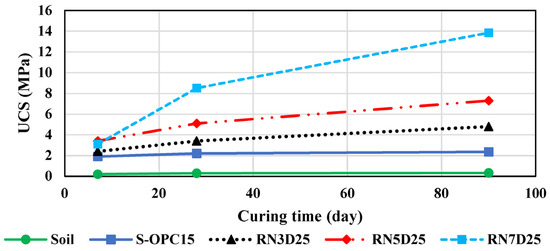
Figure 5.
The effect of alkaline activator concentration and curing time on the UCS of specimens.
4.1.3. The Effect of the CKD Absence in Geopolymer
The effect of using CKD in the Geopolymer was investigated by comparison of Group 3 and Group 5 of the specimens with compositions of each group presented in Table 3. The UCS results presented in Figure 6, show greater values for Group 3 (containing CKD) than Group 5 (without CKD), irrespective of their curing time. It can be deduced from Figure 6 that the UCS of 90-day cured samples containing CKD powder were 11.4, 7.8, and 5.5 times higher than the samples without CKD in the presence of 3, 5, and 7 M of NaOH, respectively. Evidently, the elimination of CKD significantly reduced the UCS of the stabilized soil. For example, the UCS of RN7 that was cured for 90 days was only 18% of that of RN7D25 with the same curing age. Such results clearly demonstrate the importance of CKD content in the currently developed geopolymer. Results presented in Table 2 showed that the amount of CaO in CKD was considerably greater than the soil and the RNP. In fact, the presence of CKD in the soil increases the amount of CaO in the environment. CaO reacts with water to form Ca(OH)2, as shown in Equation (2). Ca(OH)2 is absorbed in turn by alumina and silica in the soil, producing calcium-aluminate-hydrate (C-A-H) and calcium-silicate-hydrate (C-S-H), respectively, as expressed in Equations (3) and (4). This ultimately leads to the improved UCS of the stabilized soil [32].
CaO + H2O → Ca(OH)2
Ca(OH)2 + Al2O3 → C-A-H
Ca(OH)2 + SiO2 → C-S-H
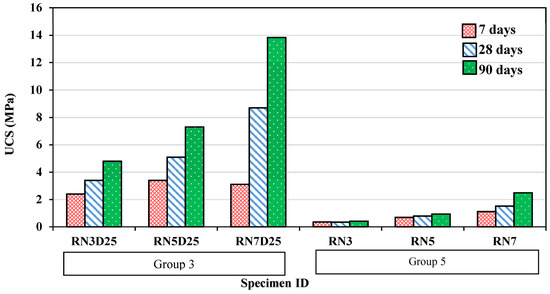
Figure 6.
Impact of NaOH molar concentration on UCS of stabilized soil by geopolymer with CKD (RND samples) and without CKD (RN samples) cured for different periods of time.
The calcium in the CKD powder has a swift reaction with NaOH and develops sodium carbonate, which causes a strength increase in specimens of Group 3.
4.1.4. The Effect of CKD Content
Group 4 specimens were defined and prepared to investigate the effect of CKD con-tent on the UCS of stabilized specimens when other parameters including RNP/Soil = 0.3 and the concentration of NaOH (5 M) were kept constant. The UCS results in Figure 7 show that an increase in the CKD content from 10 to 20% generally increases the UCS of specimens. Increasing the CKD powder adds to the amount of calcium hydroxide Ca(OH)2 (Equations (2)–(4)). This, in turn, causes the formation of more C-S-H and C-A-H, which over time leads to a greater developed strength. However, such a trend is reversed for specimens having more than 20% CKD content, especially for those cured for 28 or 90 days. This could be attributed to the presence of RNP together with CKD, which resulted in an excess number of particles that were susceptible to reaction. A proportion of these particles could not contribute to the chemical reactions and hence, the increased percent-age of unbounded particles, thereby reducing the content of UCS in CKD by greater than 20%. This is well supported by the UCS results of Group 7, in which no RNP was used, as presented in Figure 8. In specimens of group 7, the addition of more than 20% CKD re-sulted in an increase in the UCS. This will be further discussed in Section 4.1.5.
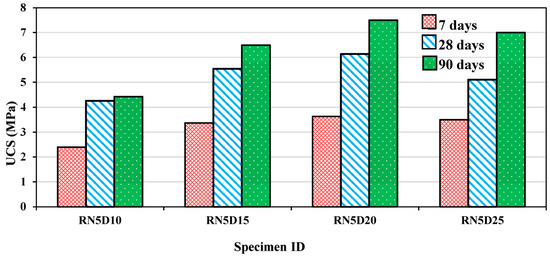
Figure 7.
The effect of CKD content on the UCS of stabilized specimens (various CKD content, NaOH 5 M, in Group 4 with geopolymer cured for 7, 28 and 90 days.
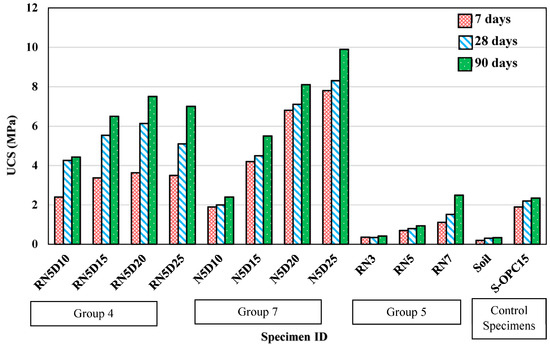
Figure 8.
Comparison of the UCS of stabilized samples in the presence (Group 4) and the absence (Group 7) of RNP at various CKD contents.
4.1.5. The Effect of Elimination of the RNP from the Geopolymer
According to the last row of Table 2, the ratio of Si/Al in raw materials of this study is greater than 3. With the increase in the CKD content in the mixing plan, the desired ratio increased, and as a result, the strength of the samples increased. As observed in Figure 7, with the increase of CKD up to 20%, the Si/Al ratio and consequently the strength of the samples increased, and beyond that, the strength of the samples decreased. This is due to the fact that the amount of aluminosilicate materials in the mixing design, which exist in both CKD and RNP, has increased excessively that NaOH (5 M) was not able to activate all of the aluminosilicate to form a geopolymer gel. Therefore, the mentioned material remained idle in the structure of the sample without reacting and did not connect to the other particles of soil to cause an increase in strength. In comparison with Figure 7, it can be seen in Figure 8 that by removing RNP from the mixing plan and reducing the amount of aluminosilicate, NaOH has been able to more effectively activate all of the aluminosilicate materials and increase the strength of the samples, even with 25% CKD content. In another comparison, the UCS of Group 3, made of a geopolymer containing a combination of CKD and RNP, and Group 6, with Geopolymer with only CKD as the base, were depicted together with unstabilized soil and stabilized using 15% OPC (Control 1 and Control 2, respectively) in Figure 9. The UCS of Group 6 specimens was higher than Group 3. For the selected specimens of N7D25 and RN7D25 the UCS values were 42.1 and 40.7 times greater than the unstabilized soil and 6.1 and 5.9 times higher than S-OPC 15 specimens, respectively. Figure 9 also indicates that specimens stabilized with geopolymer made of a combination of CKD and RNP develop a relatively similar strength to their corresponding specimen with CKD and no RNP in the geopolymer. This shows that the use of CKD as a waste byproduct by itself not only significantly improves the soil properties but also exceeds the strength achieved through the traditional cement treatment of soils.
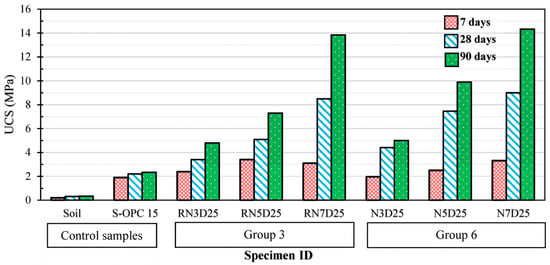
Figure 9.
Comparison of the UCS of stabilized samples in the presence (Group 3) and the absence (Group 6) of RNP at various concentrations of NaOH.
4.2. Microstructural Studies
To study the microstructure of specimens and to reach a better comprehension of changes in the UCS of different soil samples, X-ray Diffraction (XRD) and Scanning Electron Microscopy (SEM) were carried out on selected specimens of RC9D25, RN7D25, RC2D25, RN3D25, RN7, and N7D25, as well as the unstabilized soil, RNP, and CCR materials.
4.2.1. XRD Results and Analysis
The XRD test is a well-established method for mineralogical studies [33]. Figure 10 demonstrates the XRD patterns of selected specimens, namely RC9D25 and RN7D25, as well as the soil, CKD, CCR, and RNP. Figure 10 indicates that RC9D25 has a peak intensity at 2θ = 26.6°, which is an indication of a hydrated compound ((Na,Ca)Al(Si,AL)3O8). The filling action of the hydration products reduces the amount of pores and changes the morphological characteristics of the specimen, resulting in improved strength. The Calcite peak intensity at 2θ = 29.5 °, which is potentially due to the presence of CKD, is lower than that of 2θ = 28°, and new Ca(OH)2 peaks have been developed, indicating that less strength was gained over time. This is backed by the UCS results shown in Figure 4. In the determination of the presence of calcite by interpreting XRD results, the XRD pattern library and published literature, such as Sharma and Goyalit [34] were studied and checked against the outcomes obtained in the current study. It should be noted that the calcite shown in the XRD results, is partially due to existence of this material in CKD, and is partially formed through the following equations, as also discussed by Sharma and Goyalit [34]:
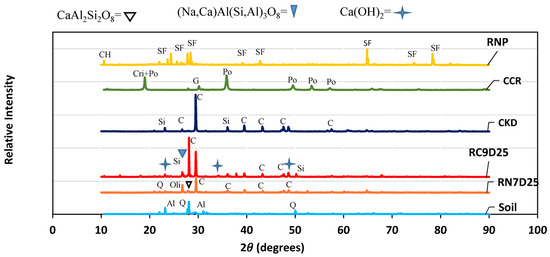
Figure 10.
XRD patterns of specimens RC9D25, RN7D25, Soil and materials CKD, CCR, RNP.
In the XRD pattern of the RN7D25 specimen, the Calcite (C) peak intensity at 2θ = 29.5° is reduced as a result of the CKD and has fewer peaks than the RC9D25, which shows greater integrity. Thus, RN7D25 was expected to develop more strength, which matches well with the UCS results of Figure 4. The lower number of peaks indicates lower crystalline materials, more efficient materials, and fewer cavities between the filler particles. In Figure 10, intensity peaks, as a result of the presence of RNP and CCR, are not observed in the patterns of RN7D25 and RC9D25. This can indicate that RNP and CCR have effectively participated in the chemical reaction, have formed new compounds, and increased the alkalinity of the environment. Therefore, the hydration reaction has turned into a geopolymerization reaction. This resulted in the formation of geopolymer gels and thus, greater strength development.
Comparing XRD patterns of RC9D25 and RN7D25 specimens with that of unstabilized soil diagrams indicates that the presence of Calcite and (Na,Ca) Al(Si,AL)3O8 peaks in the stabilized specimens has increased the soil stability. In this case, the difference in the connector type can lead to a significant difference in the XRD pattern. For example, the connector in the RC9D25 specimen is of a hydration or pozzolanic type, whereas in the RN7D25 specimen, the connector is of a geopolymer type.
In Figure 11, a comparison between the XRD pattern of RC2D25 and RN3D25 is provided. Gismondin and Calcite play a key role in developing compressive strength. The presence of organic materials which have high percentage of Calcite (CaCO3) as well as suitable content of CaSO4 in the specimens, had no tendency to interfere with the hydration process and, hence, the production of hydration crystals had increased. Stable thermodynamic hydrates such as Ca(OH)2 and Gismondin precipitated in the first reaction, which accelerated the pozzolanic reaction [35,36].
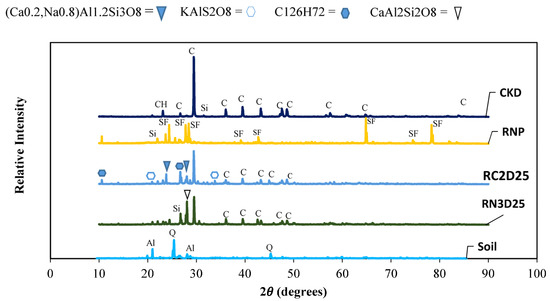
Figure 11.
XRD patterns of RC2D25, RN3D25, the soil and CKD, CCR and RNP.
It was discussed earlier that the UCS of N7D25 samples is higher than those of RN7D25 specimens. As evidenced in Figure 12, this could be due to the peaks related to N7D25 indicating that these specimens are more amorphous. In addition, based on Figure 12, it can be deduced that the presence of RNP caused higher peaks for RN7D25 than those of the N7D25, which could be due to the crystallinity of pozzolan and low dissolution of aluminosilicate pozzolan particles in the NaOH alkaline solvent. This can show the significant effect of substituting RNP with CKD.
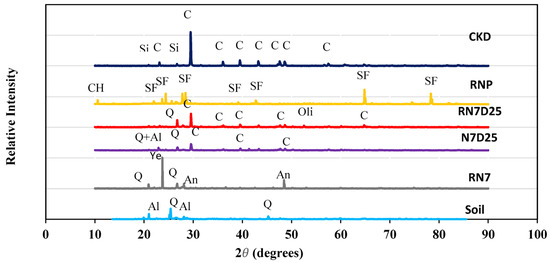
Figure 12.
XRD patterns of RN7D25, N7D25, RN7 (90 days curing) as well as the soil and CKD, CCR and RNP.
The presence of Yilmeet (Ye) in the XRD results of RN7 specimens, as demonstrated in Figure 12, can generally result in more compressive strength than unstabilized soil. However, the bond between RN7 particles is of the pozzolanic type that develops lower strength compared to other specimens.
4.2.2. Analysis of SEM Images
Figure 13 illustrates the SEM micrographs of specimens, prepared with 7 M NaOH, 0% and 25% CKD and RNP/Soil ratios equal to 0 and 0.3, all cured for 90 days. In all these specimens, soil particles (denoted by the letter “a”), monomeric binders, and geopolymer gel (marked by letters “b” and “c”, respectively) have particularly distinct phases. In Figure 13a, soil particles are shown with a higher magnification, in order to be identifiable in other images. Figure 13b,c show that the bonds in specimens with CKD are denser and more condensed than those without CKD. In the specimen containing no CKD content, monomer binders were formed between soil particles and tightened firmly, while geopolymer gels were barely seen.
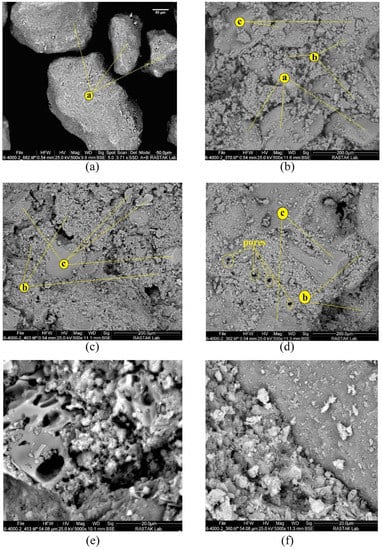
Figure 13.
SEM images of (a) Soil, (b) RN7 (0%CKD), (c) RN7D25, (d) N7D25 (0%RNP), (e) RN7D25, and (f) N7D25 prepared at 7 M NaOH and 90 days curing. b and c denote the binder phase, and a denotes the soil particles.
The calcium silicate hydrate (C-S-H) gel solely develops around oligomers and provides for continuity within the specimens. The SEM image with a high magnification of the RN7D25 specimen shown in Figure 13e indicates that gels similar to honeycomb structure are formed. In the current study, the C-S-H gels are seen in the form of honeycomb and flakes which are shown as close-up images (Figure 13e,f). Increasing the formation of C-S-H gels is rationally assumed to lead to the increase in the UCS of stabilized soil samples [15]. The monomeric binders formed and seen in Figure 13d are more than those in Figure 13c, which could be related to the presence of amorphous silica in the CKD powder. In Figure 13d, the monomeric binders have more apparent integrity and condensation than Figure 13c. The C-S-H gels in Figure 13d are flake-shaped and are more stable than the honeycomb-like binders. The formation of the geopolymer gel along with the C-S-H gel increased the strength of the specimens (Figure 13c,d). The presence of more geopolymer gel with flakes of the C-S-H gel in N7D25 specimens develops more strength than those in RN7D25 specimens. In fact, the improvement of the compressive strength by increasing the alkaline concentration is the result of the proper presence of Calcium and the formation of C-S-H gels. Such observations match the findings reported by other researchers [37]. In Figure 13d the gel fills the voids between the particles and develops a more integrated and resistant material. The formation of C-S-H gel as a common geopolymer system product has been reported by many researchers [38,39].
Figure 14 shows SEM micrographs of stabilized specimens with 3 and 7 M of NaOH, 2 and 9 % of CCR, 25% CKD content, and RNP/Soil ratio of 0.3 cured for 90 days. In this Figure, soil particles, monomeric binders, and geopolymer gel are denoted by a, b, and c, respectively. Images of Figure 14 show that by increasing alkalinity in the specimens, from 3 M of NaOH (Figure 14a) to 7 M (Figure 14b), the monomeric binders become more condensed while more geopolymer gel is formed. In Figure 14c,d, no geopolymer gel (c-type) is formed, and the binders are of pozzolanic type. Increasing alkalinity intensity from 2 % (Figure 14c) to 9 % (Figure 14d) CCR has resulted in the development of more monomeric binders. The difference between bonds shown in Figure 14 is in their density and continuity. In Figure 14c,d, the density in the bonds is less than those seen in Figure 14a,b. The reason for this is the replacement of CCR with an alkaline activator of the NaOH type. The hydration of pozzolanic reactions due to the combination of materials in the samples has led to the development of C-S-H gel with a highly porous mass. The substitution of NaOH with calcium CCR causes NaOH to penetrate C-S-H binder and modify it more rapidly. Hence, penetration of NaOH into the C-S-H gel type binders accelerates the improvement process of the soil samples. The increase in the alkaline content of the samples is directly related to the increase in carbonation of the C-S-H gel type, which leads, in turn, to silicate polymerization, and the production of a silicate-rich gel. The silicate-rich gel modifies the main C-S-H gel in favor of the formation of N-S-H gel containing Ca [40].
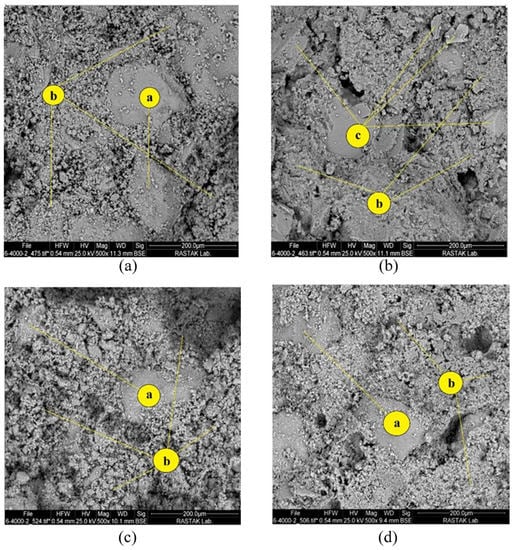
Figure 14.
SEM micrographs of specimens (a) RN3D25, (b) RN7D25, (c) RC2D25 and (d) RC9D25 after 90 days curing.
4.3. Statistical Analysis of Results
In order to better understand the relationship between the control and the quality parameters of the compressive strength of the stabilized specimens in this study, Taguchi optimization analysis was applied. The aim was to distinguish the best combination of control parameters affecting the strength characteristics. In the Taguchi method, the highest signal-to-noise (S/N) value of each parameter indicates the optimal level of that parameter [41,42,43]. The S/N is generally analyzed by three performance characteristics, being ‘larger-is-better’, ‘nominal-is-better’, and ‘smaller-is-better’. In the case of this research, since higher strengths (UCS) were desired, the ‘larger-is-better’ performance characteristics were adopted. The S/N was determined using the following equation:
where n is the number of repetitions in the trial, and y is the response value. The control factors included NaOH concentration, CKD content, RNP content, and curing time.
The analysis of variance (ANOVA) was conducted to statistically evaluate the importance of the four control factors on the UCS and to determine the contribution proportion of each. The Taguchi method was utilized to determine the optimized mixture conditions by setting the target as the highest UCS. The proportion of experimental control factors used in the current study are presented in Table 4. The S/N ratios were computed for each of the experimental control parameters, as presented in Figure 15. Evidently, a mixture of 20% CKD and 0% of RNP in the presence of 7 M NaOH proposed the highest UCS. Figure 15 demonstrates that the CKD content is the most influential factor in the UCS of stabilized geopolymer specimens.

Table 4.
Levels of the experimental control factors used for the statistical analysis.
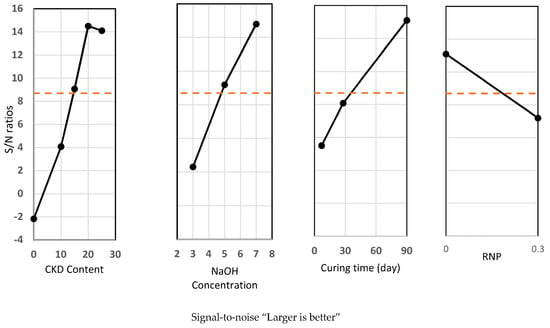
Figure 15.
Plots of the S/N ratios of control factors.
The ANOVA results for the UCS of stabilized geopolymer specimens are presented in Table 5. CKD, with the highest contribution percentage (55.1) is known as the most influential variable. Meanwhile, the variables of curing time, NaOH concentration, and RNP content were other influential variables with contribution percentages of 12.6, 9.7, and 0.3, respectively.

Table 5.
Result of ANOVA for the unconfined compressive strength.
5. Conclusions
The treatment of a poorly graded sandy soil using a geopolymer based on combinations of RNP and CKD associated with Sodium Hydroxide (NaOH) and Calcium Carbide Residue (CCR) as alkaline activators was investigated. Further, the replacement of CCR with NaOH and the substitution of RNP with CKD were examined. These replacements were carried out to concurrently improve the physical and mechanical properties of poorly graded sandy soil, and to preserve primary natural resources by recycling industry wastes using an economical and environmental approach. According to the obtained results, the following conclusions are specifically drawn with respect to the objectives “a”, “b”, and “c” set in this study, mentioned in the last paragraph of the Introduction Section.
- A key parameter in soil stabilization was the type of alkaline activator, as was sought in objectives “a” and “b”. As mentioned in Section 4.1.1, the replacement of CCR with NaOH caused an increase in the strength of the samples as much as 10.3 times in the samples containing optimal content of NaOH or CCR (7M and 9%, respectively) which were cured in 90 days. In addition, the UCS of RN7D25 was about 40.7 and 5.9 times the UCS of Control 1 (unstabilized soil) and Control 2 (cement stabilized) specimens, respectively. The stabilization process appeared to be in favor of using NaOH, since increasing the concentration of NaOH continuously and directly increased the strength of stabilized soil, while increasing CCR increased the strength up to a certain level beyond which the strength increase reversed (Figure 4).
- Regarding objective “c”, the results of this research showed that CKD powder was an integral part of the current study aimed at stabilization of soils. CKD powder is advantageous since it not only has amorphous aluminosilicate and fine particles which act favorably as filler for voids, but also its alkalinity increases alkaline intensity which can lead to the reduction of required NaOH. Further, the CKD powder increased the calcium content of samples, which acts as charge-balancing cation in the continuous and integrated geopolymer net. Samples containing CKD have far more strength than samples without it.
- The CKD-NaOH geopolymer gains more UCS than the CKD-RNP-NaOH geopolymer, which shows the benefit of replacing RNP with CKD powder. This is a process, which can preserve primary natural resources and the environment. This is a very specific result of this research and especially in connection with the objective “c”.
- The validity of the UCS test results and the effectiveness of activators were investigated using XRD analysis. The XRD analysis showed that the Calcite peak of CKD in NaOH-activated specimens was lower than that of CCR-activated samples, which increased the strength of the samples. This was consistent with the results of UCS tests. The results of XRD analysis also indicated that the absence of RNP makes the soil structure more amorphous, which increases the strength in the samples. Further investigation was carried out using SEM images taken from various soils samples. The SEM images revealed that the bond between particles in the specimens with CKD was denser than those without CKD, which could be related to the existence of amorphous silica in the CKD powder. Also, based on SEM images, it could be deduced that C-S-H gels were flakes-shaped in RNP-free samples and were more stable than honeycomb-like binders produced in the presence of RNP. In addition, one of the reasons for the higher strength of samples (without RNP) was the formation of more geopolymer gel compared to specimens with RNP.
In summary, the presented research shows that CKD, which is a hazardous waste byproduct, can be used via geopolymerization as an eco-friendly ground improvement approach. Where CKD is not available, using RNP alone can increase the UCS of problematic soils to an acceptable level. The geopolymer based on CKD is a useful alternative for cement as its production saves natural resources, requires less energy, and its mechanical strength outweighs cement.
Author Contributions
Conceptualization, M.N.M. and M.H.B.; Data curation, M.N.M. and M.M.J.; Formal analysis, M.N.M., M.M.J. and E.Y.; Investigation, M.N.M. and M.H.B.; Methodology, M.H.B. and M.M.J.; Project administration, M.H.B.; Resources, M.N.M. and M.M.J.; Supervision, M.H.B.; Validation, M.H.B., M.M.J. and E.Y.; Writing—original draft, M.N.M.; Writing—review & editing, M.H.B., M.M.J. and E.Y. All authors have read and agreed to the published version of the manuscript.
Funding
This research received no external funding.
Data Availability Statement
The authors confirm that the data supporting the findings of this study are available within the article.
Conflicts of Interest
The authors declare no conflict of interest.
References
- Namjoo, A.M.; Toufigh, M.M.; Toufigh, V. Experimental investigation of interface behaviour between different types of sand and carbon fibre polymer. Eur. J. Environ. Civ. Eng. 2021, 25, 2317–2336. [Google Scholar] [CrossRef]
- Yaghoubi, E.; Yaghoubi, M.; Guerrieri, M.; Sudarsanan, N. Improving expansive clay subgrades using recycled glass: Resilient modulus characteristics and pavement performance. Constr. Build. Mater. 2021, 302, 124384. [Google Scholar] [CrossRef]
- Yaghoubi, E.; Azadegan, O.; Li, J. Effect of surface layer thickness on the performance of lime and cement treated aggregate surfaced roads. Electron. J. Geotech. Eng. 2013, 18, 1081–1094. [Google Scholar]
- Pourabbas Bilondi, M.; Toufigh, M.M.; Toufigh, V. Experimental investigation of using a recycled glass powder-based geopolymer to improve the mechanical behavior of clay soils. Constr. Build. Mater. 2018, 170, 302–313. [Google Scholar] [CrossRef]
- Salih, N.B.; Rashed, K.A.; Abdulwahab, K. Experimental study on using cement kiln dust and plastic bottle waste to improve the geotechnical characteristics of expansive soils in Sulaimani City, Northern Iraq. J. Eng. 2022, 28, 20–38. [Google Scholar] [CrossRef]
- Hanjitsuwan, S.; Phoo-ngernkham, T.; Damrongwiriyanupap, N. Comparative study using portland cement and calcium carbide residue as a promoter in bottom ash geopolymer mortar. Constr. Build. Mater. 2017, 133, 128–134. [Google Scholar] [CrossRef]
- Ghosh, P.; Kumar, H.; Biswas, K. Fly ash and kaolinite-based geopolymers: Processing and assessment of some geotechnical properties. Int. J. Geotech. Eng. 2016, 10, 377–386. [Google Scholar] [CrossRef]
- Huang, J.; Kogbara, R.B.; Hariharan, N.; Masad, E.A.; Little, D.N. A state-of-the-art review of polymers used in soil stabilization. Constr. Build. Mater. 2021, 305, 124685. [Google Scholar] [CrossRef]
- Bondar, D.; Lynsdale, C.J.; Milestone, N.B. Alkali-activated natural pozzolan concrete as new construction material. ACI Mater. J. 2013, 110, 331–337. [Google Scholar] [CrossRef]
- Kampala, A.; Horpibulsuk, S.; Prongmanee, N.; Chinkulkijniwat, A. Influence of wet-dry cycles on compressive strength of calcium carbide residue–fly ash stabilized clay. J. Mater. Civ. Eng. 2014, 26, 633–643. [Google Scholar] [CrossRef]
- Sivaji, G.; Prasad, D.S.V.; Eswararao, B. A laboratory study on the strength improve of expansive soil treated with calcium carbide residue and fly ash. Int. J. Innov. Res. Technol. 2017, 3, 120–125. [Google Scholar]
- Phetchuay, C.; Horpibulsuk, S.; Arulrajah, A.; Suksiripattanapong, C.; Udomchai, A. Strength development in soft marine clay stabilized by fly ash and calcium carbide residue based geopolymer. Appl. Clay Sci. 2016, 127–128, 134–142. [Google Scholar] [CrossRef]
- Phummiphan, I.; Horpibulsuk, S.; Sukmak, P.; Chinkulkijniwat, A.; Arulrajah, A.; Shen, S.L. Stabilisation of marginal lateritic soil using high calcium fly ash-based geopolymer. Road Mater. Pavement Des. 2016, 17, 877–891. [Google Scholar] [CrossRef]
- Phummiphan, I.; Horpibulsuk, S.; Phoo-ngernkham, T.; Arulrajah, A.; Shen, S.-L. Marginal lateritic soil stabilized with calcium carbide residue and fly ash geopolymers as a sustainable pavement base material. J. Mater. Civ. Eng. 2017, 29, 4016195. [Google Scholar] [CrossRef]
- Pourabbas Bilondi, M.; Toufigh, M.M.; Toufigh, V. Using calcium carbide residue as an alkaline activator for glass powder–clay geopolymer. Constr. Build. Mater. 2018, 183, 417–428. [Google Scholar] [CrossRef]
- Adeyanju, E.A.; Okeke, C.A. Clay soil stabilization using cement kiln dust. IOP Conf. Ser. Mater. Sci. Eng. 2019, 640, 012080. [Google Scholar] [CrossRef]
- Naseem, A.; Mumtaz, W.; Fazal-e-Jalal; De Backer, H. Stabilization of expansive soil using tire rubber powder and cement kiln dust. Soil Mech. Found. Eng. 2019, 56, 54–58. [Google Scholar] [CrossRef]
- Ahmari, S.; Zhang, L. Utilization of cement kiln dust (CKD) to enhance mine tailings-based geopolymer bricks. Constr. Build. Mater. 2013, 40, 1002–1011. [Google Scholar] [CrossRef]
- Khater, H.M. Effect of cement kiln dust on geopolymer composition and its resistance to sulfate attack. Green Mater. 2013, 1, 36–46. [Google Scholar] [CrossRef]
- Khater, H.M. Hybrid slag geopolymer composites with durable characteristics activated by cement kiln dust. Constr. Build. Mater. 2019, 228, 116708. [Google Scholar] [CrossRef]
- Odeh, N.A.; Al-Rkaby, A.H.J. Strength, durability, and microstructures characterization of sustainable geopolymer improved clayey soil. Case Stud. Constr. Mater. 2022, 16, e00988. [Google Scholar] [CrossRef]
- Qaidi, S.M.A.; Tayeh, B.A.; Zeyad, A.M.; de Azevedo, A.R.G.; Ahmed, H.U.; Emad, W. Recycling of mine tailings for the geopolymers production: A systematic review. Case Stud. Constr. Mater. 2022, 16, e00933. [Google Scholar] [CrossRef]
- Parthiban, D.; Vijayan, D.S.; Koda, E.; Vaverkova, M.D.; Piechowicz, K.; Osinski, P.; Van, D.B. Role of industrial based precursors in the stabilization of weak soils with geopolymer—A review. Case Stud. Constr. Mater. 2022, 16, e00886. [Google Scholar] [CrossRef]
- ASTM D 422; Standard Test Method for Particle-Size Analysis of Soils. ASTM International: West Conshohocken, PA, USA, 2007; ISBN D5778-95(2000).
- ASTM D 698-07; Standard Test Methods for Laboratory Compaction Characteristics of Soil Using Standard Effort (12,400 Ft-lbf/ft3 (600 kN-m/m3)). ASTM International: West Conshohocken, PA, USA, 2007.
- Zhang, M.; Guo, H.; El-Korchi, T.; Zhang, G.; Tao, M. Experimental feasibility study of geopolymer as the next-generation soil stabilizer. Constr. Build. Mater. 2013, 47, 1468–1478. [Google Scholar] [CrossRef]
- ASTM D 2487-06; Standard Practice for Classification of Soils for Engineering Purposes (Unified Soil). ASTM International: West Conshohocken, PA, USA, 2010.
- ASTM D 854-10; Standard Test Methods for Specific Gravity of Soil Solids by Water Pycnometer. ASTM International: West Conshohocken, PA, USA, 2010.
- ASTM C 618-19; Standard Specification for Mortar for Coal Fly Ash and Raw or Calcined Natural Pozzolan for Use in Concrete. ASTM International: West Conshohocken, PA, USA, 2015.
- ASTM D 2166; Standard Test Method for Unconfined Compressive Strength of Cohesive Soil. ASTM International: West Conshohocken, PA, USA, 2016.
- Kampala, A.; Horpibulsuk, S. Engineering properties of silty clay stabilized with calcium carbide residue. J. Mater. Civ. Eng. 2013, 25, 632–644. [Google Scholar] [CrossRef]
- Adeyanju, E.; Okeke, C.A.; Akinwumi, I.; Busari, A. Subgrade stabilization using rice husk ash-based geopolymer (GRHA) and cement kiln dust (CKD). Case Stud. Constr. Mater. 2020, 13, e00388. [Google Scholar] [CrossRef]
- Sekhar, D.C.; Nayak, S. SEM and XRD investigations on lithomargic clay stabilized using granulated blast furnace slag and cement. Int. J. Geotech. Eng. 2019, 13, 615–629. [Google Scholar] [CrossRef]
- Sharma, D.; Goyal, S. Accelerated carbonation curing of cement mortars containing cement kiln dust: An effective way of CO2 sequestration and carbon footprint reduction. J. Clean. Prod. 2018, 192, 844–854. [Google Scholar] [CrossRef]
- Zhen, G.; Lu, X.; Kato, H.; Zhao, Y.; Li, Y.Y. Overview of pretreatment strategies for enhancing sewage sludge disintegration and subsequent anaerobic digestion: Current advances, full-scale application and future perspectives. Renew. Sustain. Energy Rev. 2017, 69, 559–577. [Google Scholar] [CrossRef]
- Frías, M.; Vigil de la Villa, R.; Martínez-Ramírez, S.; García-Giménez, R.; Sánchez de Rojas, M.I. Mineral phases in metakaolin-portlandite pastes cured 15 years at 60 °C. New data for scientific advancement. Appl. Clay Sci. 2020, 184, 105368. [Google Scholar] [CrossRef]
- Wu, Y.K.; Hu, X.S.; Hu, R.; Han, T.; Yu, J.L. Study on the application of an activator for steel slag powder–cement in muddy soil. Eur. J. Environ. Civ. Eng. 2017, 8189, 1–13. [Google Scholar] [CrossRef]
- Kastiukas, G.; Zhou, X. Effects of waste glass on alkali-activated tungsten mining waste: Composition and mechanical properties. Mater. Struct. Constr. 2017, 50, 194. [Google Scholar] [CrossRef]
- Pourakbar, S.; Huat, B.K. A review of alternatives traditional cementitious binders for engineering improvement of soils. Int. J. Geotech. Eng. 2017, 11, 206–216. [Google Scholar] [CrossRef]
- Wang, Y.; He, F.; Wang, J.; Hu, Q. Comparison of effects of sodium bicarbonate and sodium carbonate on the hydration and properties of Portland cement paste. Materials 2019, 12, 1033. [Google Scholar] [CrossRef] [PubMed]
- Kotcioglu, I.; Khalaji, M.N.; Cansiz, A. Heat transfer analysis of a rectangular channel having tubular router in different winglet configurations with taguchi method. Appl. Therm. Eng. 2018, 132, 637–650. [Google Scholar] [CrossRef]
- Hosseinzadeh, M.; Salari, A.; Sardarabadi, M.; Passandideh-Fard, M. Optimization and parametric analysis of a nanofluid based photovoltaic thermal system: 3D numerical model with experimental validation. Energy Convers. Manag. 2018, 160, 93–108. [Google Scholar] [CrossRef]
- Kuo, C.F.J.; Liu, J.M.; Umar, M.L.; Lan, W.L.; Huang, C.Y.; Syu, S.S. The photovoltaic-thermal system parameter optimization design and practical verification. Energy Convers. Manag. 2019, 180, 358–371. [Google Scholar] [CrossRef]
Disclaimer/Publisher’s Note: The statements, opinions and data contained in all publications are solely those of the individual author(s) and contributor(s) and not of MDPI and/or the editor(s). MDPI and/or the editor(s) disclaim responsibility for any injury to people or property resulting from any ideas, methods, instructions or products referred to in the content. |
© 2023 by the authors. Licensee MDPI, Basel, Switzerland. This article is an open access article distributed under the terms and conditions of the Creative Commons Attribution (CC BY) license (https://creativecommons.org/licenses/by/4.0/).